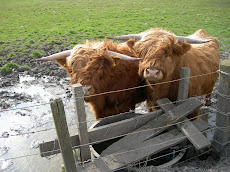Districts Set in Place to Control the Scottish/English Reivers The Border Marches of England and Scotland
The Border Laws were unique to the Border Country of England and Scotland. Initially formulated as early as 1249, they sought to control the clans of the Border territories until the Union of the two Crowns in 1603. Their origin prompted a system of administrative control.
The Border lands of the two countries are a combination of deep and fertile river valleys dominated by the Esk and Tweed and extensive areas of windswept uplands where the lonely Cheviot Hills hold sway. In medieval times to control such a vast area would have been an onerous undertaking. By the early fourteenth century a solution had been reached and the country on each side of the Border Line was divided into distinct districts known as the East, Middle and West Marches.
The East Marches
The East March of Scotland included the town of Berwick (which was to often change hands) and covered most of Berwickshire as far north as the Lammermuir Hills and west to the Hanging Stone in the Cheviots. Its English counterpart to the south included most of north-eastern Northumberland as far south as the river Aln and some of the lands of the Palinate of Durham, namely Norhamshire and Islandshire. A dominant stronghold in this area was Bamburgh Castle.
The Middle Marches
On the Scottish side this included the remainder of Berwickshire and Roxburghshire in its entirety. The principal towns were Hawick, Kelso and Jedburgh. Originally the Scottish Middle March incorporated the valley of Liddesdale within its bounds. It was such a hostile place however, known as the "Cockpit of the Borders", and one of the most dangerous places to live in the whole of Europe, that it eventually fell to separate administration. The English Middle March consisted of parts of Northumberland including Tynedale and Redesdale. The people of these valleys were akin in hostility and belligerence to their opposite numbers of Liddesdale.
The West Marches
The Scottish West March was made up of the Sheriffdom of Dumfries and the Stewartries of Annandale and Kirkcudbright. Dumfries was the major town in the Scottish West which was dominated for centuries by the clans of Maxwell and Johnstone. The March was controlled from Caerlaverock Castle. The English West encompassed the whole of Cumberland and Westmorland (modern day Cumbria). Its centre of operations was Carlisle Castle with garrisons at Askerton, Bewcastle and Rockcliffe.
The Formation of the Marches Sought to Control a Fierce, Warlike People
The clans of the Borders were hard, obdurate people inured to deprivation and incessant loss of livelihood. They answered to neither authority nor monarchy. They lived and died by a far older order, that of allegiance to their clan leader. The promulgation of the English Scottish Border Marches might have sought to bring order and peace to a land in turmoil but they needed men of a special calibre to enforce the Border Law within each of the six districts; men who were all things to all men. They would need the ability to organise and control the inhabitants of their Marches in time of war between the nations and demonstrate a firm yet impartial approach in dealing with the array of crime from theft to blackmail and murder which beset the Border country. These men were known as the March Wardens.
In 1985 I moved to the Scottish Borders and fell in love with the place. It was a surprise to find out that I knew nothing of the Border Reivers, the lawless clans who held sway in the Border country for centuries. I found their history to be absorbing and fascinating and today, twenty-five years later, the enthusiasm and passion shows no sign of waning.
I have written a book about the most infamous Scottish Border Reiver of the 16th century, Kinmont Willie Armstrong. It is called 'Deadlock and Deliverance',
Tom Moss.
For more of the rich history of the Border Reivers see my web-site at: http://www.reivershistory.co.uk
Article Source: http://EzineArticles.com/?expert=Tom_W_Moss
Tom W Moss - EzineArticles Expert Author
Subscribe to:
Post Comments (Atom)











No comments:
Post a Comment